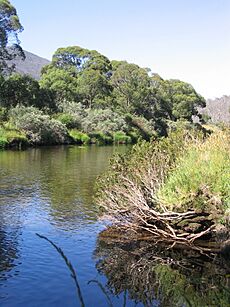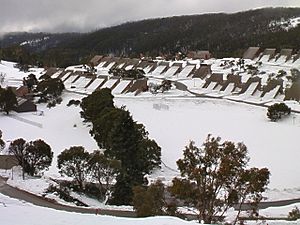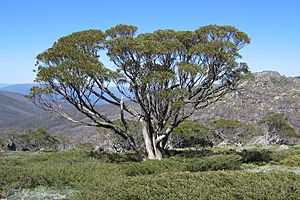Kosciuszko National Park facts for kids
Quick facts for kids Kosciuszko National ParkNew South Wales |
|
|---|---|
|
IUCN Category II (National Park)
|
|
| Nearest town or city | Cabramurra |
| Established | 1 October 1967 |
| Area | 6,900 km2 (2,664.1 sq mi) |
| Visitation | 3,279,608 (in 2018) |
| Managing authorities | NSW National Parks & Wildlife Service |
| Website | Kosciuszko National Park |
| See also | Protected areas of New South Wales |
The Kosciuszko National Park (pronounced KOZ-ee-USK-oh) is a huge protected area in Australia. It covers about 6,900 square kilometres. This park is home to Mount Kosciuszko, which is the highest mountain on mainland Australia. The park is named after this famous mountain. It also includes Cabramurra, Australia's highest town.
The park has rugged mountains and wild areas. It has an alpine climate, meaning it gets cold and snowy. This makes it a popular spot for people who love to ski and hike.
You can find Kosciuszko National Park in the southeastern part of New South Wales. It's about 354 kilometres southwest of Sydney. The park connects with the Alpine National Park in Victoria to the south. It also borders the Namadgi National Park in the Australian Capital Territory to the northeast. Nearby towns like Cooma, Tumut, and Jindabyne offer services to visitors.
Many important rivers start in this park. These include the Snowy River, the Murray River, the Murrumbidgee River, and the Gungarlin River. Other tall peaks in the park are Gungartan, Mount Jagungal, Bimberi Peak, and Mount Townsend.
In 2008, the park was added to the Australian National Heritage List. It's part of a group of eleven areas called the Australian Alps National Parks and Reserves.
Contents
Park History and Early Visitors
For a long time, Aboriginal groups from southern New South Wales visited the Australian Alps each summer. They made an annual trip to the Bogong High Plains and Snowy Mountains. Here, men would enjoy a feast of bogong moths (a type of insect) found on the mountain rocks.
Europeans first explored this area in 1835. In 1840, Edmund Strzelecki climbed Mount Kosciuszko. He renamed it after Tadeusz Kościuszko, a Polish hero and military leader. Later, stockmen brought their cattle to graze in the Snowy Mountains during summer. The famous poem, The Man From Snowy River, tells stories from this time. These cattle graziers left behind many small mountain huts. Today, volunteers and the National Parks and Wildlife Service look after these huts.
In the 1800s, people also mined for gold near Kiandra. At its busiest, about 4,000 people lived there, and it had 14 hotels! This is also where Skiing in Australia first started around 1861. Kiandra is now a ghost town with old ruins and abandoned diggings.
The Kosciuszko National Park began as the National Chase Snowy Mountains in 1906. It became the Kosciusko State Park in 1944, and then Kosciuszko National Park in 1967. The name was spelled "Kosciusko" until 1997.
Between 1949 and 1974, the Snowy Mountains Scheme was built. This huge engineering project helped explore the area, improve roads, and build many dams and tunnels.
Park Climate
The higher parts of the park have an alpine climate. This is quite rare for mainland Australia. Only the very highest peaks get heavy snow all winter. The weather station at Charlotte Pass recorded Australia's lowest temperature ever: minus 23 degrees Celsius on June 28, 1994.
Ice Age History

About 20,000 years ago, during the last ice age, the highest peaks near Mount Kosciuszko were cold enough for glaciers to form. You can still see signs of these glaciers today! There are bowl-shaped hollows called cirques, piles of rock left by glaciers called moraines, and small lakes called tarns.
Lake Cootapatamba is the highest lake on the Australian mainland. It was formed by ice flowing from Mount Kosciuszko. Other lakes like Lake Albina, Club Lake, Blue Lake, and Hedley Tarn also have glacial beginnings.
Since the 1950s, the amount of snow in the park has been decreasing.
Park Ecology: Plants and Animals
Kosciuszko National Park has different climate zones, which means it has many unique ecosystems. The alpine area, above the tree line, is very special and covers a small space. This area has different types of plants like alpine heaths, herbfields, and bogs. Some areas are very sensitive to people walking on them.
The park also has nine special "wilderness zones." These are large, untouched areas where nature is left wild.
Park Animals (Fauna)
Many rare and endangered animals live in the park. One of Australia's most threatened species, the corroboree frog, calls this park home. The endangered mountain pygmy possum and the dusky antechinus also live in the high country.
The park also has populations of wild horses, also known as brumbies. Park authorities work to manage their numbers. In 2019, it was estimated there were about 25,000 wild horses. A plan was released in 2021 to reduce their numbers to 3,000 by June 2027.
Park Plants (Flora)
Much of the park is covered by alpine woodlands. These are mostly made up of snow gum trees. Lower down, you'll find other types of forests with large alpine ash and mountain gum trees. In the southern Byadbo wilderness, there are dry forests with wattle trees.
In 2003, large bushfires seriously burned many trees in the lower parts of the park. Fires are a natural part of the park's ecosystem, but it will take time for the area to fully recover.
Fun Things to Do in the Park

Winter Activities
The mountains usually have snow several metres deep for about four months each year. This makes it perfect for skiing! The ski resorts of Thredbo, Selwyn snowfields, Perisher, and Charlotte Pass are all inside the park. The Skitube Alpine Railway is an electric train that connects the Alpine Way road to the Perisher Valley ski area.
Summer Activities
The 655-kilometre Australian Alps Walking Track goes almost the entire length of the park. Many thousands of people hike to Mount Kosciuszko in the summer. It's a 9-kilometre walk from Charlotte Pass or a 6-kilometre walk from the Thredbo chairlift. You can camp almost anywhere in the park, but you can't light fires in higher areas.
You can also go mountain biking on many trails, especially outside the wilderness zones. Some trails within wilderness zones are also open for biking.
Canoeing and swimming in the rivers and lakes are popular when the weather is warm. The rivers and dams are stocked with trout fish from nearby hatcheries. You can go fishing for trout during certain seasons if you get a permit. Other fun things to do include whitewater rafting, trail riding, and visiting the Yarrangobilly Caves. You can also see Tin Mine Falls, Australia's highest waterfall, and Valentine Falls. Guided tours are available for some caves in the karst region of Yarrangobilly.
Sawpit Creek has a big campground with places for caravans and cabins you can rent.
The Snowy Mountains Hydroelectric Scheme
The Snowy River starts in the park and flows south into Victoria. Many parts of the Snowy Mountains Scheme are located within the park. This includes tunnels, dams, and power stations that create hydro-electricity. The Tantangara Reservoir and Snowy 2.0 Pumped Storage Power Station are examples.
The Snowy Scheme was built between 1949 and 1974. It's a huge project that helps create electricity and provides water for farming. It has sixteen large dams, seven power stations, a pumping station, and 225 kilometres of tunnels and pipelines. Sir William Hudson was the chief engineer. It is the biggest engineering project ever done in Australia.
See also
 In Spanish: Parque nacional Kosciuszko para niños
In Spanish: Parque nacional Kosciuszko para niños
- Australian Alps
- Last Glacial Maximum
- National Parks in New South Wales
- Protected areas of New South Wales
- Snowy Mountains
- List of biosphere reserves in Australia






